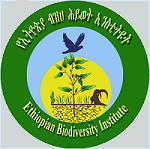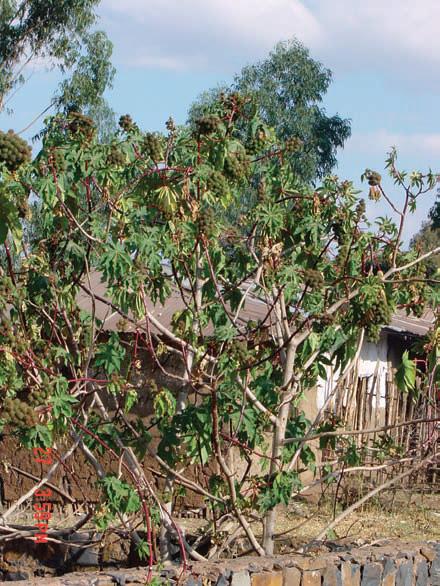 Identification of Ricinus communis, Castor Bean, for access and benefit sharing
Identification of Ricinus communis, Castor Bean, for access and benefit sharing
|
Genetic Resources Access and Benefit Sharing Directorate Identification of Ricinus communis, Castor Bean, for access and benefit sharing Reviewed by Amare Seifu
Ricinus communis March 2, 2016 1. Introduction Ethiopia is lucky to be gifted with rich biodiversity and traditional knowledge that could pioneer successful bio-prospecting. However, like any other developing countries, Ethiopia lacks technical expertise and monetary resources to explore them significantly. The only option Ethiopia has is to collaborate with the developed nations or domestic investors and interested pharmaceutical, cosmetics and other companies alike and jointly explore them strategically and wisely. In doing so, the model of collaboration should be such that it builds the science infrastructure within, preserve and protect the local traditional medicinal and other knowledge reducing the brain drain, and equally share the outcome of the joint projects On this aspect, the Ethiopian Biodiversity Institute (EBI) is the nationwide capable authority through ABS directorate playing the practical role of the Nagoya protocol on Access and Benefit sharing of genetic resources and associated traditional knowledge. Ethiopia has the officially permitted outline for the implementation of the ABS. The laws concerning the national Access and Benefit Sharing framework is proclamation on Access to genetic Resources and Community Knowledge and Community Rights (Proclamation No 482/2006) and Regulation 169/2009). Based on these frameworks, the country has been implementing the access and benefit sharing objective of the CBD. The Proclamation includes a range of issues such as ownership, user rights, and conditions for access, benefit sharing, types of benefits, powers and responsibilities among the others. Therefore, the objective of this information is to encourage any bio-prospecting company or an individual interested to work on the genetic resources, Ricinus communis, for medicinal use, production of biodiesel, nitrogen fertilizer, wallboard, livestock feed and paper products. 2. The Plant Ricinus communis is shrubby tree of the genus Ricinus (Ricinus is a Latin term for “a kind of tick,” and it refers to the resemblance of castor bean seeds to dog ticks). It belongs to the family Euphorbiaceous, spurge family and its common name is Castor bean, castor-oil plant, palma Christi, wonder tree. It is short-lived small tree or shrub with soft wood and hollow stems which can grow to 5 m or more. Its bark is greenish to reddish brown, smooth. Leaves: palmately and deeply lobed with serrate leaf margins; long-stalked, alternate, dark green or even reddish. Its flowers are crowded on upright spikes up to 40 cm long; both sexes occur on the same plant; the upper female flowers appear before the lower male ones. Its fruits are round, deep red, prickly capsules, in dense clusters; containing three tick-like, brown or reddish-brown marbled, very poisonous seeds with high oil content (Rana et al., 2012). As to ways of cultivation, it is directly sown at site. Germination is good and fast, about 90 % after three weeks. It has a weight of about 1,300 seeds per kg. It is fast-growing but short-lived plant growing as a fallow plant and on cropland. It is often found in homesteads. Flowering trees can be found throughout the year but very often after rains (Azene Bekele, 2007; Fichtl, and Admasu Adi, 1994). 2.1. Distribution Ricinus communis is a plant commonly found in both the tropical and temperate climates of the world. Ricinus communis (‘Gulo’) is a very common plant of compounds in rural and urban areas and also common along seasonally dry rivers in altitudes between 400 and 2700 m. Ethiopia is a possible centre of origin for this plant and contains a wide diversity of germplasm. It is a shrubby tree growing over a wide range of altitudes all over Africa, preferring humus-rich and disturbed ground. In Ethiopia, it is found in Moist and Wet ‘Kolla’, ‘Weyna Dega’ and ‘Dega’ agro-climatic zones of almost all regions (Fichtl, and Admasu Adi, 1994). 2.2. Ethno-medicinal uses Traditionally, the plant has been used for the treatment of various diseases in traditional or folk remedies throughout the world. The extracted oil has been used for many centuries as a purgative (strongly laxative). It is one of the safest and most reliable purgatives which relieve obstinate constipation. The leaves have been also recommended in the form of a decoction or poultice, as an application to the breasts of women to increase the secretion of milk In traditional medicine, the leaves and seeds are used as a laxative, for wound dressing, against rheumatism and mental illness (Singh and Geetanjali, 2015). The powdered leaves are used for repelling aphids, mosquitoes, white flies and rust mites. The insecticidal activity is probably due to the presence of the alkaloid ricinine in them (Rana et al., 2012). 3. Chemical composition and pharmacological activities of Ricinus Communis The individual parts of the plant such as the seed, seed oil, leaves and the roots showed their importance in pharmacology. Due to the presence of important phytochemical constituents like flavonoids, glycosides, alkaloids, steroids, terpenoids, this plant is reported to possess antioxidant, anti-inflammatory, anti-diabetic, central analgesic, anti-tumor, anti-nociceptive, anti-asthmatic activity and other medicinal properties (Jombog and Enenebeaku, 2008; Iqbal et al., 2012; Singh and Geetanjali, 2015). Other studies on castor oil suggest that its uniquely high level of the hydroxyl fatty acid ricinoleic acid may impart increased lubricity to the oil and its derivatives as compared to other vegetable oils. Ricinoleic acid, a derivative of the poisonous protein “ricin” that is found in the seeds, has been used in spermicidal lubricants, cosmetics, and anti-fungal compounds (Jombog and Enenebeaku, 2008; Goodrum and Geller, 2005, cited in Sarıbıyık et al, 2010). Generally, the treated oil finds use in products like pharmaceuticals and insecticidal formulations (Rana et al., 2012). Oil from the perennial types is used for illumination and lubrication while that from the annual types is preferred for medicinal use. Castor oil is often given orally, alone or with quinine sulphate to induce labor in pregnancy at term. The oil can be used as a vehicle for parenteral administration of steroidal hormones. It is used in the preparation of liquid disinfectants like phenyls. 'Blown Oil' is used for grinding polish paste colors, while when it is hydrogenated and sulfonated it can be used for preparation of ointments (Iqbal et al., 2012; Rana et al., 2012). 3.1. The essential oils of Ricinus Communis Castor oil is a non-toxic vegetable oil extracted from the seeds of this plant. Ricinus Communis oil is critical to many industrial applications because of its unique ability to withstand high and low temperatures (Comar et al., 2004, cited in Sarıbıyık et al., 2010). It is used in coating fabrics and other protective coverings, in the manufacture of high grade lubricants, transparent typewriter and printing inks, in textile dyeing (when converted into sulfonated Castor Oil or Turkey-Red Oil, for dyeing cotton fabrics with alizarine), in leather preservation. Hydrogenated oil is utilized in the manufacture of waxes, polishes, carbon paper, candles and crayons. It is an excellent illuminant and has been used in lamps from very early times in India (Rana et al., 2012). It is used in soap making. Castor oil is a mild and most efficient purgative, and is well-adapted for infants and young children (Friedman et al., 2013). 3.2. Biodiesel production from Ricinus Communis Oil Biodiesel is an alternative fuel for diesel engines that is produced by chemically reacting vegetable oil or animal fat with alcohol and the catalyst. Biodiesel is miscible in diesel fuel, and can be easily blended with diesel fuel with minor or no modifications to the engine and fuel system. According to EU guidelines, the consumption of bio-fuels for road transportation should represent 20% of the total fuel consumption by 2020 and the use of bio-fuels will be stimulated by environmental aspects (Hribernik and Kegl, 2007, cited in Sarıbıyık et al., 2010). The most common way to produce biodiesel is the trans-esterification method, which refers to a catalyzed chemical reaction involving vegetable oil and alcohol to yield fatty acid alkyl esters (i.e., biodiesel) and glycerol. The reaction requires a catalyst, usually a strong base, such as sodium and potassium hydroxide or sodium methyl ate. A catalyst is usually used to improve the reaction rate and the yield (Zhang et al, 2003, cited in Sarıbıyık et al., 2010). The trans-esterification conditions and biodiesel properties of Ricinus Communis oil were studied (Canoira et al, 2010, cited in Sarıbıyık et al., 2010). An optimization of trans-esterification of Ricinus Communis oil using central composite rotational design (CCRD) and response surface modeling method (RSM) has been reported by authors Sarıbıyık et al. (2010). 3.3. Ricinus Communis as nitrogen fertilizer and livestock feed Castor Oil Pomace, the residue after crushing, is used as a high-nitrogen fertilizer. Crushed seeds can be used as a high-nitrogen fertilizer and they are safe to use as a livestock feed when put through a detoxifying process. Castor cake is used as manure in India. It is rich in nitrogen and other minerals, and has been found to be suitable as manure for paddy, sugarcane, tobacco, etc. Leaves are occasionally fed to cattle. They are reported to increase the yield of milk. In addition, the stems of this small tree are used to make wallboard and paper products (Friedman et al., 2013; Rana et al., 2012). References Azene Bekele (2007). Useful trees and shrubs of Ethiopia: Identification, propagation and management in 17 Agro-climatic zones. RELMA in ICRAF Project. World Agroforestry Centre-Eastern Africa Region Programme, Nairobi, Kenya. Fichtl, R. and Admasu Adi (1994). Honeybee flora of Ethiopia. DED (German Development Service) and Ministry of Agriculture-Livestock and Fishery Resources. Weikersheim: Margraf Verlag. Friedman, M.H., Andreu, M.G., Quintana, H.V. and McKenzie, M. (2013). Ricinus communis, Castor Bean. FOR 244, Forest Resources and Conservation, Florida Cooperative Extension Service, Institute of Food and Agricultural Sciences, University of Florida. Iqbal, J., Zaib, Farooq, U., Khan, A., IrumBibi, and Suleman. S. (2012). Antioxidant, Antimicrobial, and Free Radical Scavenging Potential of aerial parts of Periploca aphylla and Ricinus communis. International Scholarly Research Network (ISRN) Pharmacology 2012:1-6. Jombog, G.T.A. and Enenebeaku, M.N.O. (2008). Antibacterial profile of fermented seed extracts of Ricinus communis: Findings from a preliminary analysis. Nigerian Journal of Physiological Sciences 23 (1-2): 55-59. Rana, M., Dhamija, H., Prashar, B. and Sharma, S. (2012). Ricinus communis L. A review. International Journal of Pharm.Tech Research CODEN (USA): IJPRIF 4(4): 1706-1711. Sarıbıyık, O.Y., Özcanli, M., Serin, H., Serin, S. and Aydin, K. (2010). Biodiesel production from Ricinus Communis oil and its blends with soybean biodiesel. Strojniški vestnik -Journal of Mechanical Engineering 56 (12): 811-816. Singh. R and Geetanjali (2015). Phytochemical and pharmacological investigations of Ricinus communis Linn. Algerian Journal of Natural Products 3(1): 120-129. |
| Release date | 19/07/2016 |
|---|---|
| Contributor | IT Team EBI |
| Geographical coverage | Identification of Ricinus communis, Castor Bean, for access and benefit sharing |
| Keywords | Ricinus communis |
Please note that this information has expired.

